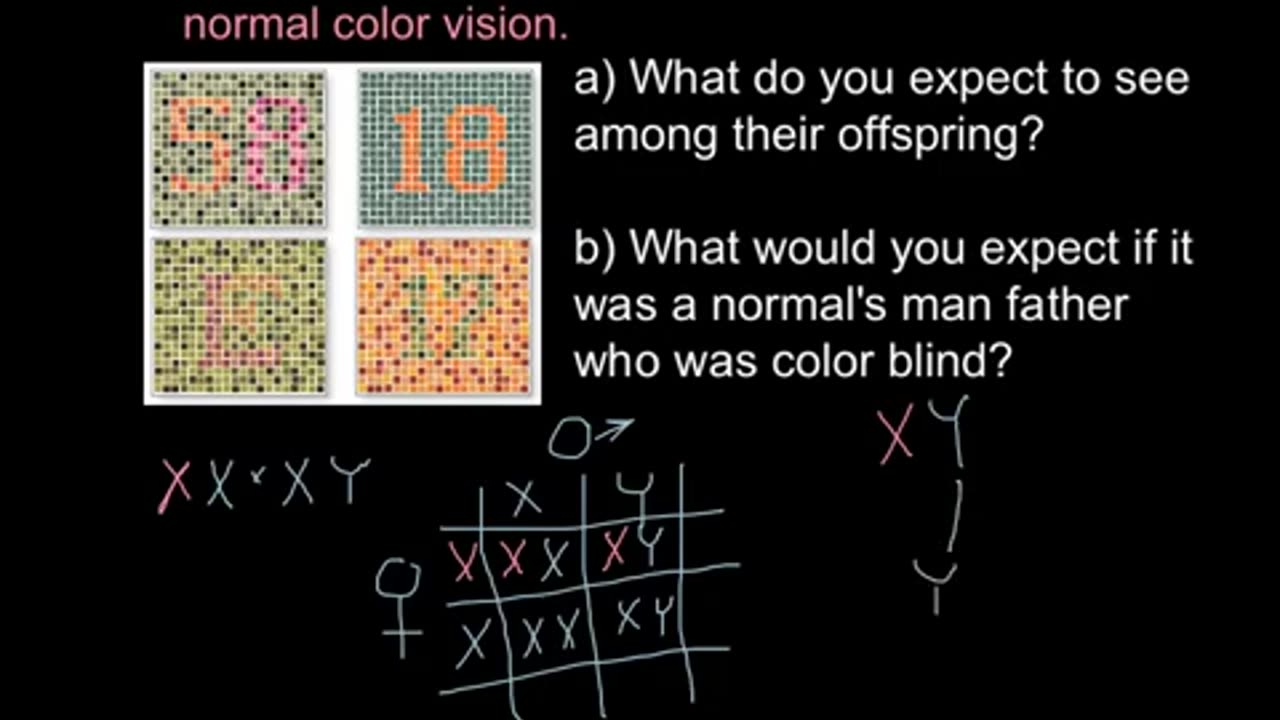Premium Only Content

Color blindness: X chromosome linked inheritance
What is color vision deficiency?
Color vision deficiencies are a group of conditions that affect the perception of color. They cause a range of changes in color vision, from mild difficulty with distinguishing shades to a total inability to detect color. These conditions are divided into three major categories: red-green color vision defects, blue-yellow color vision defects, and a complete absence of color vision.
Red-green color vision defects are the most common form of color vision deficiency. Affected individuals have trouble distinguishing between shades of red and green. They see these colors differently than most people and may have trouble naming different hues. Blue-yellow color vision defects, which are rarer, cause problems with differentiating shades of blue and green. These two forms of color vision deficiency disrupt color perception but do not affect the sharpness of vision (visual acuity).
An absence of color vision, called achromatopsia, is uncommon. People with complete achromatopsia cannot perceive any colors. They see only black, white, and shades of gray. A milder form of this condition, incomplete achromatopsia, may allow some color discrimination. People with achromatopsia almost always have additional problems with vision including reduced visual acuity, increased sensitivity to light (photophobia), and small involuntary eye movements called nystagmus.
How common is color vision deficiency?
Red-green color vision defects are the most common form of color vision deficiency. This condition affects males more often than females. Among populations with Northern European ancestry, it occurs in about 8 percent of males and 0.5 percent of females. Red-green color vision defects have a lower incidence in almost all other populations studied.
Blue-yellow color vision defects affect males and females equally. This condition occurs in fewer than 1 in 10,000 people worldwide.
Complete achromatopsia affects an estimated 1 in 30,000 people. This condition is much more common among Pingelapese islanders, who live on one of the Eastern Caroline Islands of Micronesia. Five percent to 10 percent of this population have a total absence of color vision.
What genes are related to color vision deficiency?
Mutations in the CNGA3, CNGB3, GNAT2, OPN1LW, OPN1MW, and OPN1SW genes cause color vision deficiency.
Changes in the CNGA3, CNGB3, and GNAT2 genes are responsible for achromatopsia. Each of these genes provides instructions for making a protein that is involved in the normal function of cones in the retina. Mutations in any of these genes prevent all three types of cones from reacting appropriately to light. As a result, most people with mutations in one of these genes must depend on rods alone for vision. They typically have no color vision and often have other visual problems as well. Some people with mutations in the CNGA3 gene have incomplete achromatopsia, which may allow some cone function and limited color vision.
A particular form of incomplete achromatopsia, called blue cone monochromacy, occurs when genetic changes prevent both L and M cones from functioning normally. People with this condition have only S cones. Because the brain must compare input from at least two types of cones to detect color, people who have only functional S cones have very poor color vision.
How do people inherit color vision deficiency?
The types of color vision deficiency have different patterns of inheritance. Red-green color vision defects and blue cone monochromacy are inherited in an X-linked recessive pattern. A condition is considered X-linked if the mutated gene that causes the disorder is located on the X chromosome, one of the two sex chromosomes. In males (who have only one X chromosome), one altered copy of the gene in each cell is sufficient to cause the condition. In females (who have two X chromosomes), a mutation must be present in both copies of the gene to cause the disorder. Males are affected by X-linked recessive disorders much more frequently than females. A characteristic of X-linked inheritance is that fathers cannot pass X-linked traits to their sons.
Blue-yellow color vision defects are inherited in an autosomal dominant pattern, which means one copy of the altered OPN1SW gene in each cell is sufficient to cause the condition.
-
 LIVE
LIVE
DLDAfterDark
1 hour ago $2.32 earnedDLD Live! SHTF Handguns! Which Would You Choose?
557 watching -
 1:50:38
1:50:38
Mally_Mouse
4 hours agoSaturday Shenanigans!! - Let's Play: Mario Party Jamboree
26.1K -
 1:13:00
1:13:00
Patriots With Grit
8 hours agoWill Americans Rise Up? | Jeff Calhoun
20.3K10 -
 14:55
14:55
Exploring With Nug
8 hours ago $8.20 earnedWe Found Semi Truck Containers While Searching for Missing Man!
40.4K7 -
 27:57
27:57
MYLUNCHBREAK CHANNEL PAGE
16 hours agoOff Limits to the Public - Pt 3
74.8K57 -
 38:07
38:07
Michael Franzese
9 hours agoLeaving Organized Crime and Uncovering Mob in Politics: Tudor Dixon and Michael Franzese
70.1K14 -
 2:42:54
2:42:54
Jewels Jones Live ®
2 days agoAMERICA IS BACK | A Political Rendezvous - Ep. 111
58.9K45 -
 8:47:33
8:47:33
Due Dissidence
1 day agoLIVE: Workers Strike Back Conference ft. Chris Hedges, Jill Stein, Kshama Sawant, and More!
102K55 -
 8:36:37
8:36:37
Right Side Broadcasting Network
5 days agoLIVE REPLAY: CPAC 2025 Day Three with President Donald J. Trump - 2/22/25
433K96 -
 1:05:34
1:05:34
The Big Mig™
17 hours agoConfirmed Kash Patel New FBI Director, Bring On The Pain |EP483
102K28